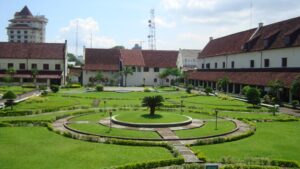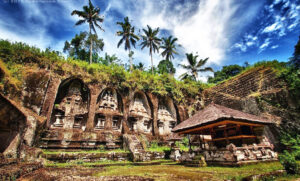
Explore the top 10 historical sites for tourists in Indonesia, showcasing the country’s rich cultural and historical heritage.
1. Borobudur Temple Indonesia:
2. Prambanan Temple:
3. Jakarta Old Town (Kota Tua):
4. Taman Sari Water Castle:
5. Ujung Water Palace:
6. Trowulan Archaeological Site:
7. Sam Poo Kong Temple:
8. Fort Rotterdam:
9. Gunung Kawi Temple:
10. Sultan’s Palace (Kraton):
1. Borobudur Temple Indonesia Indonesia:

Borobudur Temple in Indonesia is a magnificent UNESCO World Heritage Site located in Central Java, near the city of Yogyakarta.
This ancient Buddhist temple is one of the largest and most impressive in the world, dating back to the 9th century.
As you approach Borobudur, you’ll be struck by its grand scale and intricate stone carvings, which depict stories from Buddhist scriptures and teachings.
Visiting Borobudur Temple is a truly immersive experience that allows tourists to explore its nine stacked platforms, each adorned with over 2,600 relief panels and 500 Buddha statues.
As you ascend the temple, you’ll be rewarded with panoramic views of the surrounding lush landscape and distant volcanic peaks, creating a serene and awe-inspiring atmosphere.
Tourists can also participate in sunrise or sunset tours at Borobudur, offering a magical and peaceful way to witness the temple in different lighting conditions.
The temple’s design, with its mandala-shaped layout and symbolic architecture, reflects the Buddhist concept of the universe and the path to enlightenment.
In addition to its historical and cultural significance, Borobudur Temple provides a spiritual retreat for visitors seeking tranquility and reflection.
The temple’s serene surroundings and spiritual ambiance make it a popular destination for meditation and contemplation.
Overall, Borobudur Temple is a must-visit for tourists looking for historical sites and to immerse themselves in rich cultural heritage and architectural wonders of Indonesia.
Don’t miss the opportunity to explore this ancient marvel and experience the spiritual essence of Borobudur.
2. Prambanan Temple Indonesia:

Prambanan Temple, located in Central Java near Yogyakarta, is a breathtaking Hindu temple complex that stands as a testament to Indonesia’s rich cultural and architectural heritage.
Built in the 9th century, Prambanan is a UNESCO World Heritage Site renowned for its towering spires, intricate stone carvings, and stunning reliefs that depict Hindu epics and mythological stories.
As tourists approach Prambanan, they are greeted by the grandeur of the main temple dedicated to Lord Shiva, surrounded by smaller temples dedicated to other Hindu deities such as Vishnu and Brahma.
Exploring Prambanan Temple offers visitors a glimpse into Indonesia’s ancient past and the intricate craftsmanship of the Javanese people.
The temple complex consists of over 200 intricately carved temples, each with its own unique architectural style and symbolism.
Tourists can wander through the expansive grounds, marveling at the detailed carvings that adorn the walls and pillars of the temples.
One of the highlights of visiting Prambanan is witnessing the temple complex at sunset, when the golden light bathes the stone structures in a warm glow, creating a magical and unforgettable experience.
Additionally, tourists can attend traditional dance performances held at the temple complex, adding a cultural dimension to their visit.
Overall, a visit to Prambanan Temple is a must for tourists who want to immerse themselves in the historical sites, ancient history, and architectural wonders of Indonesia.
The temple’s beauty, historical significance, and spiritual ambiance make it a truly remarkable destination for travelers exploring the cultural treasures of Indonesia.
3. Jakarta Old Town (Kota Tua) Indonesia:

Jakarta Old Town, also known as Kota Tua, is a charming and historic district in the heart of Indonesia’s bustling capital city.
This area serves as a window into Jakarta’s colonial past, with well-preserved Dutch colonial architecture and a vibrant cultural scene that attracts tourists from around the world.
As tourists wander through Kota Tua, they will be transported back in time to the 17th century when the Dutch East India Company established Batavia, the precursor to modern-day Jakarta.
The cobblestone streets, colonial buildings, and bustling markets create a nostalgic atmosphere that is both captivating and educational.
Visitors to Jakarta Old Town can explore a variety of museums, including the Jakarta History Museum housed in the former city hall of Batavia, which showcases artifacts and exhibits detailing the city’s rich history.
Tourists can also visit the Wayang Museum, dedicated to traditional Indonesian puppetry, and the Fine Art and Ceramic Museum, which displays a collection of Indonesian art and ceramics.
In addition to its historical sites, Kota Tua offers a vibrant street food scene where tourists can sample local delicacies and traditional dishes of Indonesia.
The area is also home to street performers, art galleries, and cultural events that showcase Jakarta’s diverse heritage.
Overall, a visit to Jakarta Old Town is a must for tourists looking to immerse themselves in the history and culture of Indonesia’s capital city.
Kota Tua offers a unique and memorable experience for travelers seeking to discover Jakarta’s past and present.
Whether exploring the museums, sampling street food, or simply soaking in the atmosphere, visitors will find something special to enjoy.
4. Taman Sari Water Castle Indonesia:

Taman Sari Water Castle, located in Yogyakarta, Indonesia, is a fascinating historical site that offers tourists a glimpse into the royal past of the region.
Built in the 18th century as a royal garden and pleasure palace for the Sultan of Yogyakarta, Taman Sari is a complex of elegant pavilions, pools, and water gardens that once served as a retreat for the royal family.
The highlight of Taman Sari is its unique water castle, a series of bathing pools and underground tunnels that were used for relaxation and meditation by the sultan and his concubines.
Tourists visiting Taman Sari can explore the intricate architecture of the water castle and marvel at the ornate carvings and sculptures that adorn the pavilions.
They can also wander through the lush gardens that surround the complex.
The site offers a peaceful and serene atmosphere, perfect for leisurely strolls and quiet contemplation.
In addition to its historical significance, Taman Sari also provides insight into the cultural and artistic traditions of the Javanese people.
Visitors can attend traditional dance performances, art exhibitions, and craft workshops that showcase the rich heritage of Yogyakarta.
Overall, a visit to Taman Sari Water Castle is a must for tourists seeking to immerse themselves in historical sites, royal history and cultural heritage of Indonesia.
The site’s beauty, tranquility, and historical significance make it a truly enchanting destination for travelers exploring the wonders of Yogyakarta.
5. Ujung Water Palace Indonesia:

Ujung Water Palace, located in Karangasem, Bali, is a stunning and picturesque destination that offers tourists a unique blend of history, culture, and natural beauty.
Built in the early 20th century by the King of Karangasem, Ujung Water Palace served as a retreat and recreational complex for the royal family.
The palace is renowned for its intricate Balinese architecture, lush gardens, and serene water features that create a tranquil and enchanting atmosphere for visitors to explore.
All in all, tourists visiting the Ujing Water Palace can wander the vast grounds admiring the ornate pavilions, bridges and statues that reflect Bali’s rich cultural heritage.
The palace is surrounded by scenic rice fields and offers panoramic views of the Indian Ocean, making it a perfect spot for photography and relaxation.
Visitors can also stroll along the palace’s pathways, crossing over serene ponds and waterways that are teeming with colorful koi fish.
In addition to its architectural beauty, Ujung Water Palace holds historical significance as a symbol of Bali’s royal past.
Tourists can learn about the history of the palace and its connection to the Karangasem royal family through guided tours and informational exhibits.
The site also hosts cultural events, traditional dance performances, and art exhibitions that showcase the vibrant arts and traditions of Bali.
Overall, a visit to Ujung Water Palace is a must for tourists seeking to immerse themselves in the beauty and history of Bali.
The palace’s serene ambiance, stunning architecture, and cultural significance make it a truly unforgettable destination for travelers exploring the wonders of Indonesia.
6. Trowulan Archaeological Site Indonesia:

Trowulan Archaeological Site, located in East Java, Indonesia, is a fascinating destination that offers tourists a glimpse into the ancient Majapahit Empire, one of the most powerful kingdoms in Southeast Asia.
Spread across a vast area, Trowulan is a treasure trove of historical artifacts, temples, and ruins that date back to the 13th century.
The site served as the capital of the Majapahit Empire, a thriving center of trade, culture, and religion that flourished for centuries.
Tourists visiting Trowulan Archaeological Site can explore the remnants of grand temples, palaces, and bathing pools that once stood as a testament to the empire’s wealth and influence.
The site also features a museum that houses a collection of artifacts, sculptures, and inscriptions that provide insight into the daily life and customs of the Majapahit people.
Visitors can take guided tours of the archaeological site, learning about the history and significance of each structure from knowledgeable guides.
Trowulan is surrounded by lush greenery and offers a peaceful and serene atmosphere for tourists to immerse themselves in the rich history of Indonesia.
In addition to its historical importance, Trowulan also serves as a cultural hub, hosting traditional performances, art exhibitions, and craft workshops that showcase the artistic traditions of the region.
Overall, a visit to the Trowulan Archaeological Site is a must for tourists seeking to explore the ancient wonders of Indonesia and learn about the legacy of the Majapahit Empire.
The significance of historical sites, architectural beauty, and cultural richness make it a truly captivating destination for tourists interested in the history and heritage of Indonesia.
7. Sam Poo Kong Temple Indonesia:

Sam Poo Kong Temple, located in Semarang, Indonesia, is one of the historical and culturally significant sites that attracts tourists from around the world.
Also known as Gedung Batu Temple, this ancient temple holds a special place in Indonesian history as a symbol of the country’s rich cultural heritage and religious diversity.
Built in the 15th century, Sam Poo Kong Temple is believed to have been visited by the famous Chinese admiral Zheng He, also known as Sam Poo Kong, during his voyages to Indonesia.
The temple is a blend of Chinese and Javanese architectural styles, featuring intricate carvings, ornate pagodas, and colorful decorations that reflect the fusion of cultures in the region.
In addition, tourists visiting Sam Poo Kong Temple can explore its various halls, shrines, and courtyards, each offering a glimpse into the temple’s storied past.
The main hall houses a statue of Admiral Zheng He, along with other historical artifacts and relics.
Visitors can also participate in traditional ceremonies and rituals that are held at the temple, immersing themselves in the spiritual atmosphere and cultural traditions of Indonesia.
Surrounded by lush gardens and serene ponds, Sam Poo Kong Temple, therefore, provides a peaceful and tranquil setting for tourists to relax and reflect.
The temple’s serene ambiance, historical significance, and architectural beauty make it a must-visit destination for travelers seeking to experience the cultural richness of Indonesia.
A visit to Sam Poo Kong Temple is sure to leave a lasting impression on tourists.
Whether exploring the temple’s ancient halls or enjoying the peaceful surroundings, visitors can delve into the history and spirituality of Indonesia.
8. Fort Rotterdam Indonesia:

Fort Rotterdam, located in Makassar, Indonesia, is a historical gem that offers tourists a captivating journey through time.
Originally built by the Gowa Kingdom in the 16th century, the fort was later expanded and fortified by the Dutch in the 17th century, serving as a strategic stronghold and administrative center during the colonial era.
Today, Fort Rotterdam stands as a well-preserved monument to Indonesia’s colonial past, with its impressive architecture and rich history drawing visitors from around the world.
Tourists exploring Fort Rotterdam can wander through its ancient walls, bastions, and courtyards, marveling at the blend of European and traditional Bugis architectural styles.
The fort’s layout includes various sections such as the barracks, powder magazine, and commandant’s house, each offering a glimpse into the daily life and military operations of the past.
The fort also houses a museum that showcases artifacts, historical documents, and exhibits related to the region’s history, providing a deeper understanding of Makassar’s cultural heritage and colonial legacy.
Visitors to Fort Rotterdam can immerse themselves in the fort’s storied past while enjoying panoramic views of the surrounding city and sea.
The fort’s picturesque setting, with lush gardens and ancient cannons overlooking the waterfront, creates a serene atmosphere perfect for relaxation and contemplation.
A visit to Fort Rotterdam promises an enriching and memorable experience for tourists eager to discover Indonesia’s fascinating history and architectural beauty.
Whether visiting the museum, strolling through the fort’s grounds, or attending cultural events and performances, there’s something for everyone to enjoy.
9. Gunung Kawi Temple Indonesia:

Gunung Kawi Temple, nestled in the lush greenery of Tampaksiring, Bali, is a sacred site that beckons tourists to explore its mystical beauty and spiritual significance.
Carved into the rock face of a river gorge, the temple complex is a stunning example of ancient Balinese architecture and religious devotion.
Dating back to the 11th century, Gunung Kawi Temple is believed to be a memorial dedicated to King Anak Wungsu and his queens, with its towering shrines and intricate stone carvings paying homage to the royal family.
Tourists visiting Gunung Kawi Temple can embark on a scenic journey through rice terraces and tropical forests before descending into the valley where the temple is located.
The site’s serene atmosphere and natural surroundings create a sense of tranquility and reverence, inviting visitors to connect with Bali’s spiritual heritage.
The temple’s impressive rock-cut shrines, some reaching up to 23 feet in height, are a testament to the skill and artistry of ancient Balinese craftsmen.
Exploring Gunung Kawi Temple offers tourists a glimpse into Bali’s rich cultural and religious traditions, with its sacred pools, meditation caves, and holy springs adding to the mystical allure of the site.
Visitors can participate in traditional rituals, such as making offerings and seeking blessings from local priests, to experience the spiritual essence of the temple.
Whether admiring the intricate carvings, meditating by the river, or simply soaking in the peaceful ambiance, a visit to Gunung Kawi Temple promises a soul-stirring journey into the heart of Bali’s spiritual heritage.
10. Sultan’s Palace (Kraton) Indonesia:

Sultan’s Palace, also known as Kraton, is a majestic cultural landmark located in Yogyakarta, Indonesia, that offers tourists a glimpse into the rich history and royal heritage of the region.
Built in the 18th century, the palace serves as the residence of the Sultan of Yogyakarta and his royal family, making it a symbol of Javanese tradition and royalty.
Tourists visiting Sultan’s Palace can explore its grand architecture, intricate Javanese design elements, and expansive courtyards, all of which reflect the opulence and grandeur of the royal court.
The palace’s ornate pavilions, lush gardens, and traditional wooden structures create a serene and regal atmosphere that transports visitors back in time to the era of Javanese kings and queens.
Inside Sultan’s Palace, tourists can discover a treasure trove of cultural artifacts, royal heirlooms, and historical relics that offer insights into the courtly life and traditions of the Sultanate.
The palace also houses a museum that showcases traditional Javanese art, music, dance, and ceremonial objects, providing a comprehensive overview of Yogyakarta’s cultural heritage.
Visitors can witness traditional performances, such as gamelan music and Javanese dance, that highlight the artistic prowess and cultural richness of the region.
Exploring Sultan’s Palace allows tourists to immerse themselves in the royal legacy of Yogyakarta and gain a deeper appreciation for Indonesia’s diverse cultural tapestry.
Whether admiring the intricate carvings, attending cultural events, or simply marveling at the palace’s grandeur, a visit to Sultan’s Palace promises an unforgettable journey into the heart of Javanese royalty and tradition.







